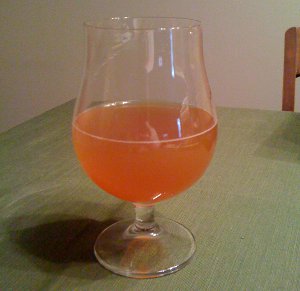After two weeks in the fermenter, I went ahead and bottled the Bavarian Hefeweizen yesterday. I probably could have bottled it a few days ago, but I decided to give it a little more time, especially since I don’t really do secondary fermentation – that’s a process where I would transfer the beer from the primary fermenter to a secondary, separating it from the majority of the yeast and giving it a chance to condition and clear. However, I only really have one fermenting bucket, and besides, transferring the beer opens it up to the air and the possibility of infection (by wild yeast strains, bacteria, etc…) I’m pretty good about sanitation, but still, the less chances for mistakes the better. Also, Hefeweizens are supposed to be cloudy – the name itself literally translates to “yeast wheat”, or “wheat beer with yeast”. The question of whether or not to use secondary fermentation seems to be a pretty contentious one, but for simplicity’s sake, I’m going to stick with only using the primary for now.
The final gravity was 1.010. For some reason, Northern Brewer never mentions target gravity for any of their kits. Nevertheless, for a beer with a starting gravity of ~1.050, that final gravity was appropriate. My previous two batches came in a little lower than I was expecting, but this one was just what I was hoping for (in monitoring temperatures, it seems that conditions were ideal for this batch). Doing the math on this, I find that this will be a 5.25% ABV beer, which is just about perfect for the style.
As with my previous two attempts, the bottling process went smoothly. I did invest in an auto-siphon this time around, and yes, it was worth every penny. Not that getting a siphon to work was particularly difficult, just that it was a huge pain in the ass to get going. The auto-siphon makes that process very easy. Otherwise, nothing new to report – sanitizing bottles is a tedious chore, filling and capping the bottles is a little more fun, but also tedious and repetitive. I ended up just shy of two full cases of beer.
Like last time, the beer looked and smelled fantastic. It’s a little brighter than I expected, but I expect it to darken up a bit as it conditions in the bottles (about 3-4 weeks after bottling the tripel, the color was significantly changed). The smell was really wonderful – all due to the yeast I used. It’s a German yeast, but it has very distinct characteristics that I usually associate with Belgian yeasts. I really can’t wait to try this beer!

If all goes well, this should be ready to drink in 1-2 weeks (definitely in time for my next beer club meeting)… Indeed, it should be reaching full maturity right as summer is hitting, which is perfect. That pretty much covers it for this beer, and I’m already attempting to work out a recipe for my next beer. I’m looking to make a Belgian style Saison (in the mold of Saison Dupont or Ommegang Hennepin). Most of the kits I’ve found haven’t quite met my expectations, so I might actually have to try my hand at a more free-form recipe. In particular, I’m a little worried about what yeast to use. My understanding is that some saison yeasts require high temperatures (in the 80°F – 90°F range) and will often putter out early if conditions aren’t just right. As such, I may end up using some sort of alternative, as I have little control over temperature (interestingly, the temp for the Hefeweizen was just about perfect).
(Cross Posted on Kaedrin Beer Blog)